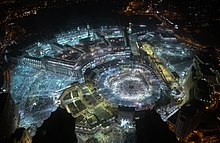
Back Meuseujid al-Haram ACE Al-Masdjid al-Haram Afrikaans المسجد الحرام Arabic المسجد الحرام ARZ মক্কাৰ মছজিদ Assamese Masjid al-Haram AST Məscidül-Həram Azerbaijani Әл-Харам мәсете Bashkir Masjid al-Haram BAN Masjid al-Haram BDR
| Al-Masjid al-Ḥarām | |
|---|---|
 | |
| Religion | |
| Affiliation | Islam |
| Province | Makkah |
| Region | Hejaz |
| Ecclesiastical or organizational status | Mosque |
| Leadership | Yasser Al-Dosari (Imam) Abdur Rahman As-Sudais (Imam) Abdullah Awad Al Juhany (Imam) Maher Al Mueaqly (Imam) Salih bin Abdullah al Humaid (Imam) Faisal Ghazawi (Imam) Bandar Baleela (Imam) Ali Ahmed Mullah (Chief Mu'azzin) |
| Location | |
| Location | Mecca, Saudi Arabia |
| Geographic coordinates | 21°25′19.2″N 39°49′33.6″E / 21.422000°N 39.826000°E |
| Architecture | |
| Architectural type | Mosque |
| Architectural style | Islamic |
| Specifications | |
| Capacity | 2.5 million[1] |
| Minaret(s) | 9 |
| Minaret height | 89 metres (292 ft) |
Al-Masjid al-Ḥarām (Arabic: ٱَلْمَسْجِدُ ٱلْحَرَامُ, romanized: al-Masjid al-Ḥarām, lit. 'The Sacred Mosque', IPA: [ʔælˈmæsʤɪd ælħɑˈrɑːm]), is the largest mosque in the world. It is in the city of Mecca, Saudi Arabia. It is considered the holiest place on Earth by Muslims. It surrounds the Kaaba (a building which Muslims face while offering daily prayers). Besides the Kaaba, the mosque also contains other important sites, such as the Black Stone (which is a part of the Kaaba), the Zamzam Well, Maqam Ibrahim (footprint of Abraham) and the hills of Safa and Marwa.[2] The mosque is also known as the Grand Mosque or the Great Mosque of Mecca.[3] Masjid al-Haram is also the most expensive building on earth.[4][5]
The mosque has been controlled by a lot of rulers. They all made contributions to the mosque in the form of expansions, renovations and decorations. Today, the mosque is under the rule of the King of Saudi Arabia.[6] The latest major expansion was during King Fahd's reign. Further expansion was planned by the former ruler, King Abdullah. This mosque has nine minarets and three large domes. Like Masjid al-Nabawi in Medina, it also has undergone many renovations and expansions.[7]
- ↑ "AL HARAM". makkah-madinah.accor.com.
- ↑ [Qur'an 3:97]
- ↑ "Great Mosque of Mecca | History, Expansion, & Facts". Encyclopedia Britannica. Archived from the original on 11 December 2019. Retrieved 2020-08-08.
- ↑ "Economy Middle East Guide: Most expensive buildings in the world". Economy Middle East. Retrieved 2024-01-17.
- ↑ "10 most expensive buildings across the globe that are worth billions". Lifestyle Asia India. 2023-02-08. Retrieved 2024-01-17.
- ↑ "Is Saudi Arabia Ready for Moderate Islam? - Latest Gulf News". www.fairobserver.com. 3 November 2017. Archived from the original on 1 December 2017. Retrieved 2017-11-25.
- ↑ "Orientation". Archived from the original on 2007-04-09. Retrieved 2009-04-12.